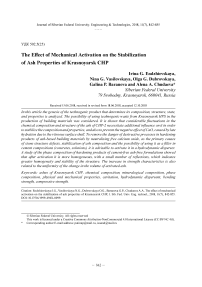Влияние механоактивации на стабилизацию свойств золы уноса красноярских ТЭЦ
Автор: Енджиевская И.Г., Василовская Н.Г., Дубровская О.Г., Баранова Г.П., Чудаева А.А.
Журнал: Журнал Сибирского федерального университета. Серия: Техника и технологии @technologies-sfu
Статья в выпуске: 7 т.11, 2018 года.
Бесплатный доступ
В данной статье анализировался генезис техногенного продукта, определяющий его состав, структуру, состояние, свойства. Рассматривалась возможность использования техногенных отходов Красноярских ТЭЦ в производстве строительных материалов. Показано, что значительные колебания в химическом составе и строении золы ТЭЦ-2 обусловливают необходимость дополнительного воздействия на нее в целях стабилизации состава и свойств, а также для предотвращения негативного влияния СаОсвоб., вызванного поздними сроками гидратирования из-за стекловидной поверхностной оболочки. Для снятия опасности деструктивных процессов в продуктах твердения строительных материалов на основе золы путем нейтрализации свободного оксида кальция, как первопричины дефектов структуры камня, стабилизации состава золы и возможности использования ее в качестве наполнителя в цементных композициях (бетонах, растворах) целесообразно активировать ее в гидродинамическом диспергаторе. Изучение фазового состава продуктов твердения бесцементных составов на основе золы показало, что после активации он более однородный, с малым количеством отражений, что свидетельствует о большей гомогенности и стабильности структуры. Повышение прочностных характеристик связано в том числе с равномерностью изменения объема активированной золы.
Золы красноярских тэц, химический состав, минералогический состав, фазовый состав, физико-механические свойства, кавитация, гидродинамический диспергатор, прочность при изгибе, прочность при сжатии
Короткий адрес: https://sciup.org/146279552
IDR: 146279552 | DOI: 10.17516/1999-494X-0099
Список литературы Влияние механоактивации на стабилизацию свойств золы уноса красноярских ТЭЦ
- Sinyak Yu.V. The concept of global economic development and energy. Forecasting problems, MAIK, "Science", Moscow, 1998, 3, 56-73
- Review of the state and environmental pollution in the Russian Federation for 2007. Roshydromet, 2008, 164 p
- OJSC "Yenisei TGC (TGC 13) Access: http://elib.sfu-kras.ru/handle/2311/34415
- Ecological efficiency of coal gasification technology on the example of Krasnoyarsk agglomeration [Electronic resource-Access:http://modernproblems.org.ru/ecology/24-hlebopros8.html
- Kuzmich N.P. Expanding the resource base of the construction complex based on the use of local raw materials and energy-efficient technologies. Eurasian International Scientific Analytical Journal. 2012, 2 (42), 325-328.
- Yezhov A.I. Evaluation of technogenic raw materials in the Russian Federation (Solid minerals). Mountain science and technology. 2016, 4, 62-72.
- Adeeva L.N., Borbat V.F. Zola CHPP is a promising raw material for industry. Vestn. Ohm Un-that. 2009, 2, 141-151.
- Cherepanov A.A., Kardash V.T. Integrated processing of ash and slag waste of CHP (results of laboratory and pilot tests). Geology and minerals of the oceans. 2009, 2, 98-115.
- Kalashnikov V.I., Belyakova E.A., Moskvin R.N., Moroz M.N., Ibragimov R.A. Priority directions in technology of concrete. Composite building materials. Theory and Practice: Coll. international scientific tech. conf. 2013, 39-42.
- Tselykovsky Yu.K. Some problems of using ash and slag waste from thermal power plants in Russia. Energetic. 1998, 7, 29-34.
- Babak N.A. Geoecological reserve of technologies, materials and structures in construction using industrial mineral waste. News PGUPS. 2011, 1. 113-119.
- Tselykovsky Yu.K. Experience of industrial use of ash and slag waste from thermal power plants Yu.K. Tselykovsky New in the Russian power industry. Energy Publishing. 2000, 2, 22-31.
- Berry E.E., Malhotra V.M. Fly Ash for use in concrete -a critical review. Acij. 1982, 2(3), 59-73.
- Vatin, NI, Petrosov, DV, Kalachev, AI, Lakhtinen, P., Application of Ashes and Ashes and Slag Waste in Construction. Engineering and Construction Journal. 2011, 4, 16-21.
- Bazhenov Yu.M. New Century New Concrete [Building materials, equipment, technologies of the XXI century, 2000, 2, 10-11.
- Bazhenov Yu.M., Demyanova B.C., Kalashnikov V.I. Modified high-strength concrete, Moscow, DIA, 2007, 368 p.
- Kalashnikov V.I., Borisov A.A., Polyakov L.G. et al. Modern ideas about the use of commodities and materials and VNV in concrete, Construction materials, 2000, 7, 12-13.
- Kalashnikov VI, Moroz M.N. High-hydrophobic multicomponent low-slag fine-grained concrete Scientific Herald of the Voronezh State University of Architecture and Civil Engineering. Construction and architecture, 2010, 1, 106-111.
- Moroz M.N., Kalashnikov V.I., Erofeeva I.V. Effective concretes of a new generation with low specific consumption of cement per unit of strength. Young Scientist, 2015, 6, 189-191.
- Moroz M.N. Vysokovitaminnye mineralology composite materials, dis.... kand. tech. sciences’. Penza, 2007, 210 р.
- Pugin K.G., Yushkov V.S. Construction of roads with the use of man-made materials. Volga Scientific Herald, 2012, 4 (8), 25-30
- Entin Z.B. Ashes TES-raw materials for cement and concrete. Cement and its application, 2012, 2, 40-46
- Entin ZB, Strzhalovskaya N. Once again about the fly ash of thermal power plants. Cement and its application, 2009, 106-111
- Nguyen Dinh Chin, Nguyen Thé Vinh, Bazhenov Yu.M. High-strength concretes with complex use of rice husk ash, fly ash and superplasticizers. Vestnik MGSU, 2011, 1. 76-81
- Kapustin F.L. Technological and environmental aspects of the use of fly ash from the Reftinskaya GRES in the production of building materials. Concrete technology, 2011, 7(8), 64-65
- Rakhimova N.R. Effect of ash additives on the properties of slag alkaline and concrete. Building materials, equipment, technologies of the XXI century, 2007, 3, 36-37
- Thomas M.D.A., Bamforth P.B. Modeling Chloride Diffusion in Concrete: Effect of Fly Ash and Slag. Cement and Concrete Research, Vol. 29, 1999, 487 -495.
- Safarov K.B., Stepanova V.F. Regulation of the reactivity of aggregates and increase of the sulfate resistance of concrete by the joint use of low-calcium fly ash and highly active metakaolin. Construction Materials, 2016, 5, 70-73
- Makarenko S.V., Konovalov N.P. Investigation of the physicochemical properties of the ashes of CHP-9 and the New Irkutsk CHP for use in ash-alkali binders. Construction Materials, 2011, 6, 60-62
- Complex system of CSM utilization. -Access: http://ksfenix.org
- GOST 25818-2017 "Fly ash of thermal power plants for concrete. Technical conditions. "Instead, GOST 25818-91; Enter 03.01.2017, Moscow: Standardinform, 2017.


